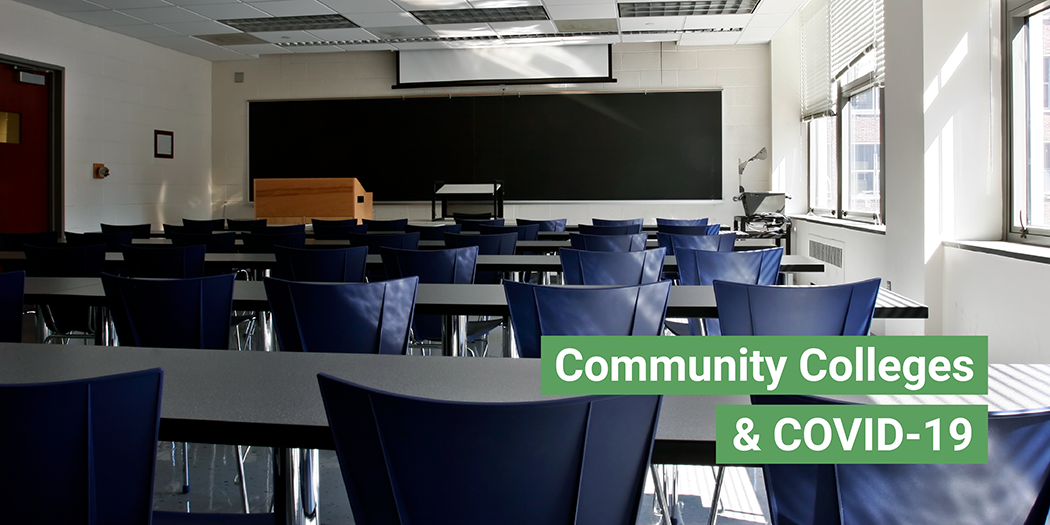Community colleges across the country are rapidly adapting to new circumstances caused by the coronavirus pandemic, and though campuses and state systems must make individual policy decisions, they face some common challenges. CCRC recently met with its Advisory Board—which includes a dozen leaders from community colleges, college systems, and governmental and national organizations—for a discussion about the rapidly changing landscape. Though each spoke from their experience, we heard several common challenges and concerns.
The transition to remote learning
The quick and necessary adoption of digital learning has affected the entire education system, and community colleges are no exception. Campuses across the nation have moved to a totally remote online environment, with some states and students poised to succeed more than others.
On the one hand, places like Wake Tech Community College in North Carolina—which has invested in its digital infrastructure for the last six years and has trained the vast majority of full- and part-time faculty in online teaching—are better prepared to navigate the transition, though it has still proved demanding. In addition to moving to remote instruction, Wake Tech relocated its student support resources to a centralized information hub accessible online and over the phone. Community and technical colleges in Washington State also started with a strong infrastructure for e-learning firmly in place. Other states and colleges, however, have found the move to remote learning more challenging, and some campuses have had to secure additional video conferencing licenses and make available lendable laptops so instructors and students can continue their work.
Additionally, just because a college is prepared to move instruction online doesn’t mean students are prepared to access it. In Washington, where America’s coronavirus outbreak began, officials quickly realized that a large number of their students lacked Internet access, effectively barring them from continuing their studies. Rural students and low-income students are more likely to lack a broadband connection, so closing the Wi-Fi gap is an essential equity challenge that colleges must overcome. In Washington, Wisconsin, and North Carolina, some colleges have used their resources to purchase and distribute equipment like laptops and hotspots for students who need them. And Washington community colleges are working with universities and the K-12 sector to expand broadband access in parts of the state with limited access and to identify joint local solutions for all their students.
Colleges also must decide how to handle the lab or practicum components of their technical courses. At Wake Tech, instructors plan to front-load the lecture-based portions of each course with the hope that they’ll be able to convene with students in-person for the lab sessions by the end of the semester. If that isn’t possible, the courses may be paused and students will receive a temporary incomplete grade. Meanwhile, in Wisconsin, the state’s nursing board decided that if students have completed 75% of their clinical requirements, then they will be able to earn their associate degree and take an abbreviated certification test.
Finally, officials in Washington and Virginia were concerned that traditional college placement procedures, including administration of the Accuplacer, could put students and staff at risk of exposure to the virus. In response, they decided to implement a version of multiple measures assessment and placement, relying on data including high school transcripts to make placement decisions instead of traditional tests. They are implementing this new policy statewide.
Equity
Leaders in several states expressed concern about student withdrawals, which may widen equity and attainment gaps. Virginia and Florida extended their withdrawal deadlines, and at Palm Beach State College in Florida, officials are reaching out to students who exercise that option to offer them alternatives and encourage them to come back to campus in the future. They are concerned that some students are simply disappearing, which could affect their financial aid eligibility down the road.
Non-degree programs raise particular challenges for equity and attainment gaps. Many adult basic education and English as a second language courses will not likely be able to transition to online instruction, which may mean these students are dropped from college completely.
Finally, as one leader from California noted, this may not be the only cycle of the pandemic. This crisis inevitably affects students across the socioeconomic spectrum in different ways, and confronting those disparities will be essential moving forward. It is important to examine student outcomes over time and to pay close attention to how the most vulnerable students fare during and after the crisis to determine if equity and attainment gaps widen.
Transfer
Many community colleges have transitioned to a pass/fail grading system for the current semester, raising questions about the transferability of credits to four-year colleges and universities, which traditionally require letter grades. In Virginia, the community college system implemented a modified pass/ withdrawal/ incomplete grading scale for the spring semester that gives students the option to receive a letter grade or decide to take the course pass/fail. Students who choose pass/fail and who earn a C or better in the course will receive a P+ on their transcripts, while those who pass with a lower grade will get a P. Officials canvassed public and private four-year colleges and universities throughout the state to confirm the transferability of P+ grades.
Community colleges’ financial future
Community colleges often see an influx of students during economic downturns, but some campus leaders are less certain that this dynamic will play out following the coronavirus. Despite an unprecedented spike in unemployment, one leader in Wisconsin speculated that many workers may be so in need of income that they will return to jobs in the retail and food industries once the crisis subsides. This could leave campuses emptier than they were before the pandemic.
Financial challenges are also on the minds of officials in Washington, where spring quarter enrollment has dipped, tuition payments are delayed, and budget cuts may be looming. The unknowns around enrollment make it challenging for administrators to plan course sections, schedules, and staffing.
What’s next
As public health restriction measures and other circumstances continue to evolve, college leaders and policy makers will undoubtedly make more decisions that will affect community colleges and their students. Several participants in our recent Advisory Board discussion noted that some of the significant, large-scale changes in practice occurring now—such as the shift to online instruction or adoption of multiple measures placement—may benefit from careful study. CCRC will partner with states and institutions to understand the effects of these broad changes and will strive to remain a resource for the field by conducting research that will benefit community colleges in the future.





